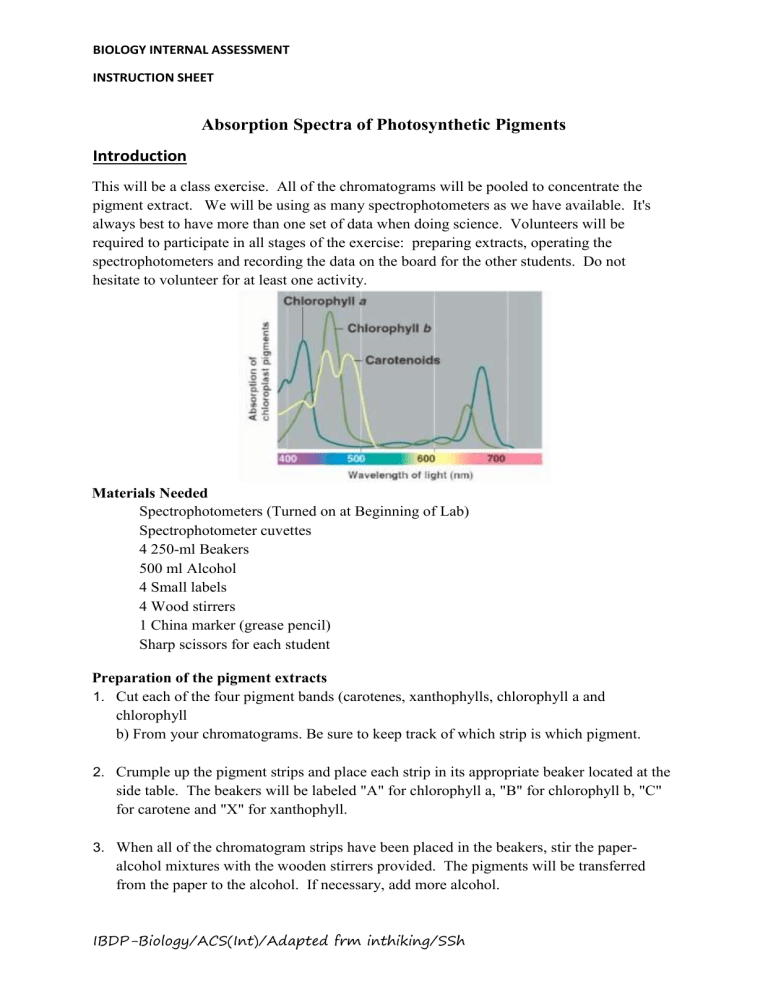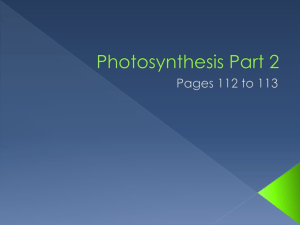
BIOLOGY INTERNAL ASSESSMENT INSTRUCTION SHEET Absorption Spectra of Photosynthetic Pigments Introduction This will be a class exercise. All of the chromatograms will be pooled to concentrate the pigment extract. We will be using as many spectrophotometers as we have available. It's always best to have more than one set of data when doing science. Volunteers will be required to participate in all stages of the exercise: preparing extracts, operating the spectrophotometers and recording the data on the board for the other students. Do not hesitate to volunteer for at least one activity. Materials Needed Spectrophotometers (Turned on at Beginning of Lab) Spectrophotometer cuvettes 4 250-ml Beakers 500 ml Alcohol 4 Small labels 4 Wood stirrers 1 China marker (grease pencil) Sharp scissors for each student Preparation of the pigment extracts 1. Cut each of the four pigment bands (carotenes, xanthophylls, chlorophyll a and chlorophyll b) From your chromatograms. Be sure to keep track of which strip is which pigment. 2. Crumple up the pigment strips and place each strip in its appropriate beaker located at the side table. The beakers will be labeled "A" for chlorophyll a, "B" for chlorophyll b, "C" for carotene and "X" for xanthophyll. 3. When all of the chromatogram strips have been placed in the beakers, stir the paper- alcohol mixtures with the wooden stirrers provided. The pigments will be transferred from the paper to the alcohol. If necessary, add more alcohol. IBDP-Biology/ACS(Int)/Adapted frm inthiking/SSh BIOLOGY INTERNAL ASSESSMENT INSTRUCTION SHEET 4. Pour extract into 4 cuvettes for each spectrophotometer available. Be sure that you know which cuvette has which pigment. Avoid getting paper fragments in the extract. Pour alcohol into a fifth cuvette. This will be the blank. 5. Take one set of the four pigment extracts and a "blank" containing alcohol to each of the spectrophotometers available. Collecting the absorption data You will measure light absorption at 50 nm intervals from 400 nm 700 nm for the absorption spectra of the leaf pigments, but you will start at 400 nm. 1. Set the wavelength to 400nm and make any other instrument adjustments that are mentioned in the spectrophotometer manual. 2. Standardize the absorbance to "0" using the blank cuvette containing alcohol, following the instructions available in the spectrophotometer handout. Each time you change the wavelength selection, you must repeat this step. Remove the alcohol blank cuvette. The spectrophotometers should have spaces for four cuvettes. 3. Place each of your pigment samples in one of the chambers. Keep track of which chambers the pigments are in. 4. Close the cover and read (and record) the absorbance on the meter for your first pigment. Repeat for each of the pigments by shifting the cuvette chambers into the correct position for reading the absorbance. 5. Record the absorbance numbers for 400 nm for each of the four pigments on the chart on board for the class data. 6. Change the wavelength to 450 nm and repeat steps 1 – 5 for 450 nm wavelength. 7. Change the wavelength to 500 nm and repeat steps 1 – 5 for 500 nm wavelength. 8. Change the wavelength to 550 nm and repeat steps 1 – 5 for 550 nm wavelength. 9. Change the wavelength to 600 nm and repeat steps 1 – 5 for 600 nm wavelength. 10. Change the wavelength to 650 nm and repeat steps 1 – 5 for 650 nm wavelength. 11. Change the wavelength to 700 nm and repeat steps 1 – 5 for 700 nm wavelength. IBDP-Biology/ACS(Int)/Adapted frm inthiking/SSh BIOLOGY INTERNAL ASSESSMENT INSTRUCTION SHEET Wavelength (nm) Absorbance of Leaf Pigments Absorbance Chlorophyll a Chlorophyll b Carotene Xanthophyll 400 450 500 550 600 650 700 Graph the class average data for each pigment. Absorbance should be on the y axis and wavelength on the x axis. A b s o r b a n c e 2 1.9 1.8 1.7 1.6 1.5 1.4 1.3 1.2 1.1 1.0 0.9 0.8 0.7 0.6 0.5 0.4 0.3 0.2 0.1 0 400 450 500 550 600 Wavelength (nm) IBDP-Biology/ACS(Int)/Adapted frm inthiking/SSh 650 700 BIOLOGY INTERNAL ASSESSMENT INSTRUCTION SHEET Discussion Questions 1. What wavelength is absorbed best by chlorophyll a? Are there additional wavelengths absorbed well by chlorophyll a? What wavelength(s) is(are) absorbed poorly by chlorophyll a? 2. Is the absorption spectrum for chlorophyll b different from that of chlorophyll a? 3. Would you expect a plant to photosynthesize if exposed to only the green wavelengths of light? Why or why not? 4. What are the advantages of having accessory pigments? IBDP-Biology/ACS(Int)/Adapted frm inthiking/SSh BIOLOGY INTERNAL ASSESSMENT INSTRUCTION SHEET IBDP-Biology/ACS(Int)/Adapted frm inthiking/SSh

